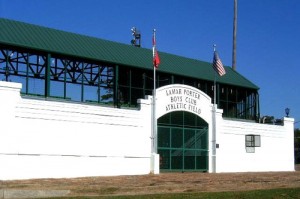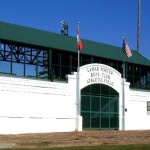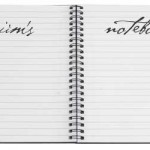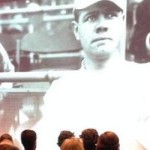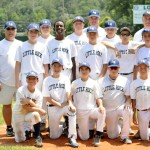Brooks Robinson is coming home. He also had a birthday Saturday. He turned 76.
Robinson, the Little Rock native who was inducted into the Arkansas Sports Hall of Fame in 1978 and the Baseball Hall of Fame in 1983, will be at Lamar Porter Field on Saturday, June 15, to draw attention to the historic complex.
The field is owned by the Boys & Girls Club of Central Arkansas. Those associated with it want to make sure it doesn’t meet the same fate as nearby Ray Winder Field.
Do you get as sick as I do each time you travel down Interstate 630 and see the ghastly UAMS parking lot that occupies the site that was long the home of Ray Winder Field?
“The sadness of witnessing the demise of Ray Winder fills me with gratitude that Lamar Porter doesn’t suffer the same fate,” says Little Rock businessman Jay Rogers. “Lamar Porter is now the oldest usable field in the state of Arkansas.”
In late 2011, the Lamar Porter Complex Revitalization Committee was formed. In addition to renovating the baseball field, the committee hopes to fund improvements at the Billy Mitchell Boys and Girls Club, the Woodruff Gardens and adjoining recreational areas. Lamar Porter Field was built between 1934 and 1937 by the Works Progress Administration as part of the Roosevelt administration’s efforts to put people to work during the Great Depression. It was an impressive concrete-and-steel facility that could seat 1,500 people. It was also the only baseball field in the state with electric lights.
The 10-acre site that includes the baseball field was given to what was then known as the Little Rock Boys Club in honor of Lamar Porter. The Little Rock native was a junior at Washington and Lee University in Virginia when he was killed in an automobile accident on May 12, 1934. In addition to donating the land, the family contributed money for construction. The first anniversary of Porter’s death coincided with Mother’s Day. The donation was announced that day by his mother, Louise Skillern Porter. Lamar Porter’s nephew, who shares his name, is among the trustees for the revitalization committee.
“A memorial serves no purpose if it ceases to exist,” says the younger Porter. “This complex needs revitalization soon or it will meet the same fate as Ray Winder Field.”
The June 15 event will begin at 5:30 p.m. and is scheduled to end by 7:30 p.m. Tickets are $10 each and are available at The SportStop on Rodney Parham Road. The business is owned by Rogers. Each ticket will be good for admission to the event, a hot dog, a soft drink, popcorn and a chance to get Robinson’s autograph.
Robinson remains a legendary figure in Baltimore, where he spent his major league career. Following his retirement at the end of the 1977 season, Robinson began a 16-year career as a television announcer for the Orioles. He was elected to the Baseball Hall of Fame in his first year of eligibility. He’s one of only six former Orioles to have had a number retired by the team.
Was Brooks Robinson the best third baseman to ever play the game?
Many baseball historians think so. He began playing the sport almost as soon as he could walk. Robinson’s father, a fireman, had played semipro baseball and also was a member of the 1937 International Harvester softball team from Little Rock that played in the finals of the World Softball Championship in Chicago.
“Brooks Robinson began playing baseball at the grammar school level as a catcher for the Woodruff School,” Jeff Bailey wrote for the online Encyclopedia of Arkansas History & Culture. “He spent much of his time practicing at the facilities of the Arkansas School for the Deaf, which was across the street from his home. He also worked the scoreboard and sold cold drinks during games played at Lamar Porter Field. While a student at Pulaski Heights Junior High, Robinson played quarterback for the 1951 junior high state championship football team and was an honorable mention on the all-state team.”
Robinson played basketball and ran track at Little Rock High School. During the summer, he played American Legion baseball for the M.M. Eberts Post No. 1’s team, the Doughboys. The Doughboys won American Legion state championships in both 1952 and 1953.
As soon as Robinson graduated from high school in 1955, he signed a contract with the Orioles. Having just turned 18, he first played for the Orioles’ farm team in York, Pa., in the Piedmont League. Late in the season, Robinson earned a promotion to the big leagues. By the 1958 season, he was the Orioles’ regular third baseman.
Known as the Human Vacuum Cleaner, Robinson won an amazing 16 consecutive Gold Glove Awards (1960-75). His best season offensively came in 1964 when he batted .317 with 28 home runs and 118 RBI. He was the American League MVP that year, receiving 18 of the 20 first-place votes. Mickey Mantle was second in the voting.
In 1966, Robinson was the MVP at the All-Star Game. He finished second that year behind teammate Frank Robinson in the American League MVP balloting as the Orioles defeated the Los Angeles Dodgers in the World Series. The Orioles would win two World Series while Brooks Robinson was playing for them. The second came in 1970 when he was the World Series MVP against the Cincinnati Reds.
The Orioles had lost the World Series to the New York Mets the previous season. In 1970, however, it was almost as if Robinson willed them to a championship.
Robinson had a .583 batting average in the 1970 American League Championship Series against the Minnesota Twins. In the World Series against the Cincinnati Reds, Robinson had a .429 batting average with two home runs and some incredible defensive plays.
“I’m beginning to see Brooks in my sleep,” Reds Manager Sparky Anderson said. “If I dropped this paper plate, he would pick it up on one hop and throw me out at first.”
As the World Series MVP, Robinson was awarded a new Toyota.
Reds catcher Johnny Bench said, “Gee, if we had known he wanted a new car that bad, we would have chipped in and bought him one.”
Robinson played in his last World Series in 1971 as the Orioles lost to the Pittsburgh Pirates in seven games. Baltimore would win division titles in 1973 and 1974 but lose in the American League Championship Series.
Robinson was selected for the American League All-Star team for 15 consecutive years from 1960-74. His career batting average was .267 with 2,848 hits, 268 home runs and 1,357 RBI. He led the American League in fielding percentage 11 times. He retired with a .971 fielding average, the highest ever for a third baseman.
At the time of his retirement, Robinson also had the records for a third baseman for games played at third (2,870), putouts (2,697), assists (6,205) and double plays (618). Only Carl Yastrzemski, Hank Aaron and Stan Musial played more games during their careers for one franchise.
Yet another Robinson record came from hitting into four triple plays during his career.
“I wouldn’t mind seeing someone erase my record of hitting into triple plays,” he later said.
How popular was Brooks Robinson in Baltimore, even after he retired?
In 1982, WMAR-TV’s on-air announcers had been on strike for two months leading into the baseball season. When Robinson refused to cross the picket line as opening day approached, station executives began new negotiations. The strike ended the next day, and Robinson was on the air for the season opener.
Robinson and Baltimore Colts’ quarterback Johnny Unitas had plaques in their honor in Baltimore’s venerable Memorial Stadium. The two men were saluted on the field when the Orioles played their last game there on Oct. 6, 1991.
In 1999, The Sporting News placed the native Arkansan on its list of the 100 Greatest Baseball Players. He also was named to the All-Time Rawlings Gold Glove Team.
Veteran Associated Press sportswriter Gordon Beard was the emcee for the ceremony that marked Robinson’s last game at Memorial Stadium in 1977. Beard reminded the crowd of Reggie Jackson’s remark: “If I played in New York, they would name a candy bar after me.”
“Around here,” Beard said, “nobody has named a candy bar after Brooks Robinson. We name our children after him.”
Now, Robinson is coming back to Little Rock to lend a hand to those who are saving Lamar Porter Field.
Little Rock’s Catholic High School for Boys and Episcopal Collegiate High School use Lamar Porter Field for home games. The field and an adjoining space also are the Arkansas home of a national program known as Reviving Baseball in the Inner City, which is sponsored by Major League Baseball. Portions of the movie “A Soldier’s Story,” starring Denzel Washington, were filmed at the field in 1984. In December 1990, the facility was placed on the National Register of Historic Places.
There are other positive things going on in the neighborhood. The Woodruff Community Garden allows novice and experienced gardeners to have plots in the city. The renovation project will add lights, security updates, a more secure gardening shed, a gate and fencing to the community garden. There also will be restoration work on historic stone walls and bridges. Other improvements will take place at the Billy Mitchell Boys & Girls Club, which is named after the man who became associated with the club in 1922 and began heading the organization in 1928. Mitchell, who had played basketball at Texas A&M, was connected with the club for more than 50 years. Construction on the current facility was completed in 1982.
In December 2011, the revitalization committee announced that an anonymous donor had given a significant gift to begin the process of planning the renovation effort. In January 2012, representatives of the Little Rock architectural firm Witsell Evans Rasco met with the committee. Last August, the firm’s initial renderings for renovating the complex were approved.
Robinson agreed in September to become the honorary chairman of the revitalization committee.
“Not only did I sharpen my baseball skills at Lamar Porter, I even once won a bubble-blowing contest there and proudly rode a new bicycle home,” he said. “The memories of playing there and the friendships that I made have lasted all my life.”
In October, the Boys & Girls Club of Central Arkansas and the Lamar Porter Complex Revitalization Committee announced a partnership with the Cal Ripken Sr. Foundation of Baltimore. The foundation was founded in 2001 by Hall of Famer Cal Ripken Jr. and his brother, Bill Ripken, who also played professional baseball for the Orioles. Cal Ripken Sr., who died in 1999, had a 37-year career working for the Orioles. The Ripken Foundation seeks to serve underserved youth across the country, using baseball as the hook to reach boys and softball to reach girls.
The revitalization committee’s website contains the words “heading for home.” With a master plan now in place, it’s a fitting motto as the great Brooks Robinson heads home to Little Rock, determined that the city won’t see another historic treasure turned into a parking lot.



